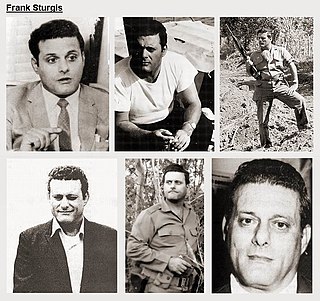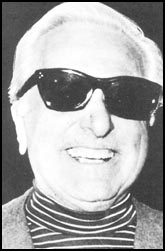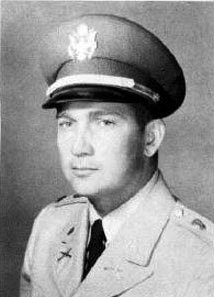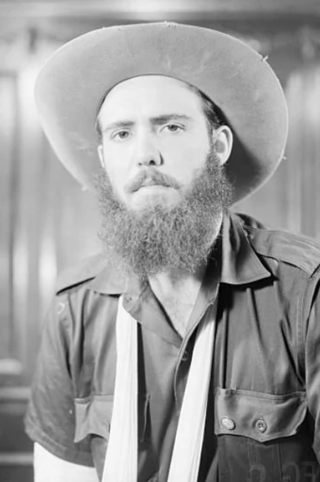
A pipe bomb is an improvised explosive device (IED) that uses a tightly sealed section of pipe filled with an explosive material. The containment provided by the pipe means that simple low explosives can be used to produce a relatively large explosion due to the containment causing increased pressure. The fragmentation of the pipe itself creates potentially lethal shrapnel.

Frank Anthony Sturgis, born Frank Angelo Fiorini, was one of the five Watergate burglars whose capture led to the end of the presidency of Richard Nixon.

Santo Trafficante Jr. was among the most powerful Mafia bosses in the United States. He headed the Trafficante crime family from 1954 to 1987 and controlled organized criminal operations in Florida and Cuba, which had previously been consolidated from several rival gangs by his father, Santo Trafficante Sr.
Omega 7 was an anti-Castro Cuban group based in Florida and New York made up of Cuban exiles whose stated goal was to overthrow Fidel Castro. The group had fewer than 20 members. According to the Global Terrorism Database, Omega 7 was responsible for at least 55 known anti-Castro attacks over the span of eight years with a majority of them being bombs. The group also took part in multiple high-profile murders and assassination attempts and has committed four known murders. Among their assassinations was Felix Garcia Rodriguez, a Cuban delegate who was gunned down on the 6th anniversary of the group. The group had conspired to assassinate Fidel Castro during the Cuban leader's visit to the United Nations in 1979.

John"Handsome Johnny"Roselli, sometimes spelled Rosselli, was a mobster for the Chicago Outfit who helped that organization exert influence over Hollywood and the Las Vegas Strip. Roselli was recruited by the Central Intelligence Agency (CIA) in a plot to assassinate Cuban leader Fidel Castro.

The Cuban Project, also known as Operation Mongoose, was an extensive campaign of terrorist attacks against civilians, and covert operations, carried out by the U.S. Central Intelligence Agency in Cuba. It was officially authorized on November 30, 1961, by U.S. President John F. Kennedy. The name "Operation Mongoose" was agreed to at a White House meeting on November 4, 1961.

Luis Clemente Posada Carriles was a Cuban exile militant and Central Intelligence Agency (CIA) agent. He was considered a terrorist by the United States' Federal Bureau of Investigation (FBI) and the Government of Cuba, among others.

Cohiba is a brand for two kinds of premium cigar, one produced in Cuba for Habanos S.A., the Cuban state-owned tobacco company, and the other produced in the Dominican Republic for US-based General Cigar Company.
The Death Merchant is the title and lead character of a series of men's action-adventure books written by Joseph Rupert Rosenberger and published by Pinnacle Books from 1971 to 1988. Richard Joseph Camellion, as described in the books, is a master of disguise, the martial arts and wet-work. Cynical and lethal in equal measure, his normal employer was the CIA – at a cost of $100,000 a mission.

Juan Almeida Bosque was a Cuban politician and one of the original commanders of the insurgent forces in the Cuban Revolution. After the rebels took power in 1959, he was a prominent figure in the Communist Party of Cuba. At the time of his death, he was a Vice-President of the Cuban Council of State and was its third ranking member. He received several decorations, and national and international awards, including the title of "Hero of the Republic of Cuba" and the Order of Máximo Gómez.

638 Ways to Kill Castro is a Channel 4 documentary film, broadcast in the United Kingdom on 28 November 2006, which tells the story of some of the numerous attempts of the Central Intelligence Agency to kill Cuba's leader Fidel Castro. It was directed by Dollan Cannell.

Ilona Marita Lorenz was a German woman who had an affair with Fidel Castro in 1959 and in January 1960 was involved in an assassination attempt by the CIA on Castro's life.
Robert Aime Maheu was an American businessman and lawyer, who worked for the FBI and CIA, and as the chief executive of Nevada operations for the industrialist Howard Hughes.
This article deals with the activities of the Central Intelligence Agency (CIA) of the federal government of the United States that constitute violations of human rights.

Salvatore "Mooney" Giancana was an American mobster who was boss of the Chicago Outfit from 1957 to 1966.
The CIA Kennedy assassination is a prominent John F. Kennedy assassination conspiracy theory. According to ABC News, the Central Intelligence Agency (CIA) is represented in nearly every theory that involves American conspirators. The secretive nature of the CIA, and the conjecture surrounding the high-profile political assassinations in the United States during the 1960s, has made the CIA a plausible suspect for some who believe in a conspiracy. Conspiracy theorists have ascribed various motives for CIA involvement in the assassination of President Kennedy, including Kennedy's firing of CIA director Allen Dulles, Kennedy's refusal to provide air support to the Bay of Pigs invasion, Kennedy's plan to cut the agency's budget by 20 percent, and the belief that the president was weak on communism. In 1979, the House Select Committee on Assassinations (HSCA) concluded that the CIA was not involved in the assassination of Kennedy.

The assassination of John F. Kennedy on November 22, 1963, has spawned numerous conspiracy theories. These theories allege the involvement of the CIA, the Mafia, Vice President Lyndon B. Johnson, Cuban Prime Minister Fidel Castro, the KGB, or some combination of these individuals and entities. Some conspiracy theories have alleged a coverup by parts of the federal government, such as the original FBI investigators, the Warren Commission, or the CIA. Former Los Angeles District Attorney Vincent Bugliosi estimated that a total of 42 groups, 82 assassins, and 214 people had been accused at one time or another in various conspiracy scenarios.

The United States' Central Intelligence Agency (CIA) made numerous unsuccessful attempts to assassinate Cuban leader Fidel Castro. There were also attempts by Cuban exiles, sometimes in cooperation with the CIA. The 1975 Church Committee claimed eight proven CIA assassination attempts between 1960 and 1965. In 1976, President Gerald Ford issued an Executive Order banning political assassinations. In 2006, Fabián Escalante, former chief of Cuba's intelligence, stated that there had been 634 assassination schemes or attempts. The last known plot to assassinate Castro was by Cuban exiles in 2000.
Castro's Beard is a play by British playwright Brian Stewart. The play centers on the true plots by the CIA to assassinate Fidel Castro in the 1960s.

Rolando Cubela Secades was a Cuban revolutionary leader who played a vital part in the Cuban Revolution, having been a founding member of the Directorio Revolucionario Estudiantil and later the military leader of the DRE's Escambray Mountain front, achieving the rank of Commander, the highest military rank in the Revolutionary Army. After the Revolution succeeded in 1959, Cubela became Cuba's envoy to UNESCO. Under the cryptonym AM/LASH, Cubela became "an important asset" of the Central Intelligence Agency, and worked with them on plots to assassinate Fidel Castro. In 1966, Cubela was arrested for plotting the assassination of Castro, and sentenced to 25 years in prison. Released in 1979, he went into exile in Spain.
















